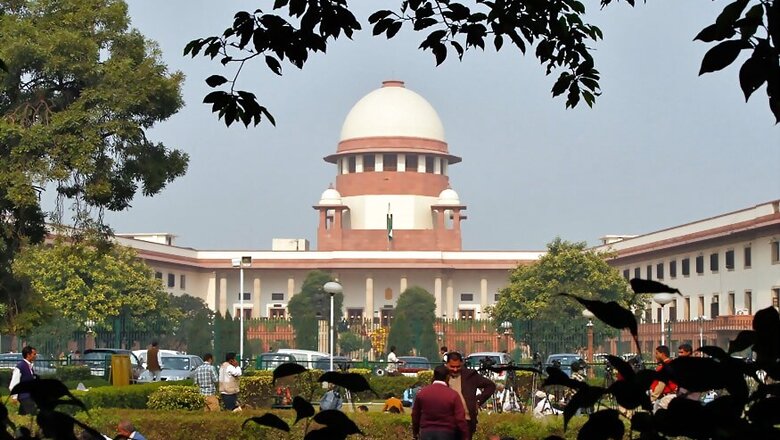
views
The Central government and judiciary have been locking horns over appointment of judges. The Chief Justice of India on Saturday blamed the government for not doing enough for appointing High court judges, following which the Law Minister responded with a counter accusation.
What lies behind this growing trouble between the government and judiciary? It is the Memorandum of Procedure (MoP) which will govern appointment of judges in future.
The Supreme court, in a judgment, struck down the government’s effort to have a say in matters of appointment and transfer of high court and supreme court judges. Since the judgment, the government and the Supreme Court Collegium have not been able to draft rules (MoP) for appointment of judges.
Below are key flash points between the two sides.
KEY FLASH POINTS:
1) Seniority and Merit:
*The government wants the criteria of seniority, merit and integrity while promoting a HC justice of judge to the SC.
*The judiciary says the criteria of seniority, subject to merit and integrity, would be followed.
* On August 3, 2016 the government finally agreed to seniority being the main criteria for elevation rather than merit-cum-seniority, which it was insisting earlier.
2) Power to reject candidates:
*Government proposes to retain power for rejection of candidates recommended by the Collegium on grounds of national security/public interest.
*The judiciary is opposed to this, saying it amounted to interference in the functioning of the judiciary.
3) Writing down Reasons:
*For transparency and to avoid favouritism, the government wants that in case a senior Chief Justice is being overlooked for elevation to the Supreme Court, the reasons for the same be recorded in writing. The government says that of the five judges of the Collegium for appointing Supreme Court judges, the views of each one must be made known to the government.
*The judiciary says recordings of reasons for overlooking a Chief Justice or a senior Judge will be counter-productive as the reasons specified may mar his/her prospects of being elevated to the Supreme Court at a future point of time. Also, it may also affect his/her duties as judge or Chief Justice and may become a permanent blot on his/her career.
4) Binding Recommendation:
*The core of the problem is the binding nature of the Collegium’s recommendation. As per the existing system, the Collegium’s recommendations can be sent back but if it reiterates then the same, it is binding on the President.
*The government says three important judgments of 1993, 1998 and 2015 on appointment of judges do not give absolute powers to the Collegium. Instead, they ask for “participatory consultative process at the highest level”.
5) Three-judge Quota:
*The government proposed that up to three judges may be appointed from the Bar or from distinguished jurists with proven track records. And that all judges of the Supreme Court should be open to recommend names for these postings.
*The judiciary says that this “up to three” tantamount to either restricting the intake from the bar or fixing a quota of the bar. And in neither case does it fall within the framework of the Constitutional provisions.
(Subsequently, after deliberation, the government has agreed with this view that fixing a limit is not necessary so long as their representation is assured.)
6) Consultative Mechanism:
*The government proposes to set up a committee to assist the Collegium in evaluation of candidates. It wants two retired judges of the SC and an eminent person/jurist to be jointly nominated by the Chief Justice of India and the government. The government counters that “wider consultation is necessary to select best candidates”.
* The Collegium feels that is not necessary.
7) Candidates” Database:
*The government proposes a secretariat that maintains a database of judges, schedules Collegium meetings, maintains records and receives recommendations and complaints related to judges’ postings. The government wants the secretariat to be under the law ministry.
*The judiciary is okay with it so long as the forming and functioning of the secretariat is left to the CJI and it should be under the ambit of the Registrar of the supreme court.
8) Cases and vacancies piling up
*Attorney General Mukul Rohatgi pointed out to SC that non-finalisation of the MoP was coming in the way of the government in clearing the recommendations of names forwarded by the SC collegiums in February 2016.
*Chief Justice Thakur argued that in the absence of a new MoP, appointments could be made on the basis of the old MoP.
*Attorney General, on 11 November 2016, told the Supreme Court that "Out of total 77 names, 34 names have been cleared for the appointment and rest 43 recommendations have been sent back to the apex court collegium for reconsideration".
*However, a bench comprising Chief Justice TS Thakur and AR Dave said that "We have reiterated 43 names for the appointment of judges of high courts which were rejected by the government and have been sent back for reconsideration".
*The reiteration of 43 names by the collegium has apparently put the government in a bind as under the prevailing MoP, it is binding on the government to make the appointment of judges if the collegium reiterates its recommended names.

















Comments
0 comment